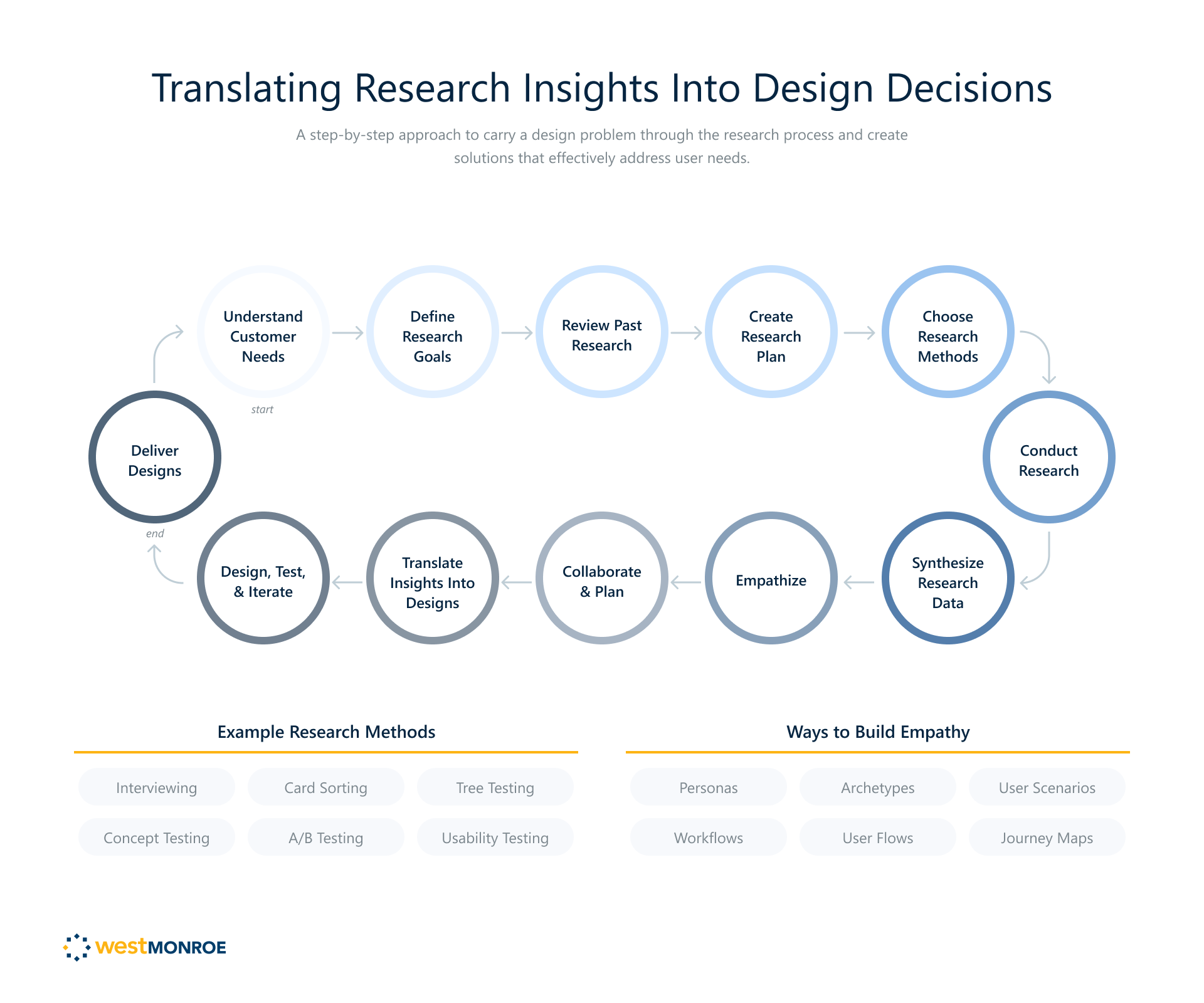
July 24, 2023 | Design
How to translate UX research insights into impactful design decisions
How to translate UX research insights into impactful design decisions
UX research can be a highly effective tool in driving experiences to meet and exceed user expectations, resulting in more favorable outcomes for businesses and the customers they serve. Utilizing research to optimize a user experience requires thoughtful planning and collaboration to ensure that it is effective in delivering those benefits. Without careful coordination, research can fail to provide useful direction and become disconnected from the design decisions. We often see well-executed research not being leveraged in a way that has a clear “so what?” for product designers and other stakeholders to make decisions.
We’ll break down how to make sure UX research provides the greatest impact possible on experiences—and how to frame and organize a relevant research approach.
Steps to consider when building an effective UX research plan
Start with defining your UX research goals
It’s important to define useful, relevant research goals—and, by extension, research questions. By establishing the right goals, we can lay the groundwork for successful UX research practices and inform the methods we’ll use to answer our key questions. Writing good research goals involves analyzing the central design question and ensuring that those goals align with the objectives of the larger design effort.
The next aspect to consider when writing research goals is what you’d want to learn from your research. UX research studies we’ve run have generally had between three to five research goals—this number can shift based on the scope and length of the work. It’s also prudent to not be leading in the goals you create; we may have a hypothesis about something, but it’s important to keep research goals neutral from that. They should guide the research and ensure the outcomes of the research study are linked to a design effort.
For example, a good research goal would sound something like this: “Understand what transactional actions customers would like to see on the homepage of the digital experience.” This goal is open-ended, but also gives us enough focus to answer the question. In this case, our research questions would need to guide us towards understanding what those transactional actions are and whether there’s evidence that it should exist on the homepage of this hypothetical experience. The set-up of this goal allowed us to easily translate our eventual findings into actionable design recommendations.
A bad research goal could be something like this: “Figure out what should exist on the homepage,” or “determine how a simpler homepage would perform better than a complex homepage.” While some direction could be gathered from these goals, they are either too leading or don’t provide enough structure for us to build cohesive study questions around them. If the question is too vague (or is leading), it can undermine the research questions that underline the research work.
Define your UX research methods
One of the most important benefits of writing good research goals is that it allows us to pinpoint the types of research methods we’ll need to use. If we take the example of the good research goal above, we can quickly tell that there might be multiple ways to answer the question. One could involve multiple-choice questions with participants ranking and selecting different transactional actions they think should exist within the homepage. There is also room for interview-style questions, where we could ask participants what they do in their own experiences, what features they'd like to see, and why they came up with those answers. Additionally, if the research goal is more concerned about navigation, information architecture (IA) , or feature placement, then a research method like a tree test starting on the homepage could help researchers visually see what features or elements participants are gravitating towards.
Gain alignment among stakeholders, PMs, researchers & designers
Before you can solidify your goals and research methods, it’s critical to build alignment with all immediate stakeholders.UX research in isolation is not conducive to actionable design insights and practical improvements in experiences. It’s critical to work with PMs, designers, leaders, and others involved to understand their perspectives and questions. It’s good practice to incorporate these elements into the research approach and to structure the goals and study in a way that the research output acknowledges the input and requirements from stakeholders. This approach will lead to a quicker turnaround time, a more effective analysis of research findings, and create more actionable design insights. It will also simplify the overall research and design process as everyone is in alignment.
Researchers should be involved in pushing design insights further—while also participating in the ideation of design concepts by providing more detailed insights and recommendations. These efforts can help bridge the gap between the research and its implementation in design.
In a recent project with a healthcare insurance client, we engaged in work to revamp their homepage experience. We established a thorough research-based protocol to transform the homepage and achieve positive improvements for potential users while meeting stakeholder objectives. Meeting these goals was only possible through applying research practically and directly to designs. This involved researchers and designers ideating on features, information hierarchy, and preliminary design concepts as a team—with an emphasis placed on tying in and justifying the UX research output to various design decisions that were made.
A step-by-step approach to translating research insights into design decisions (with examples)
These are steps we took in a previous project to establish a research approach and output that can broadly be applied to other UX research efforts:
- Identified customer and stakeholder objectives; devised a central design question and effort based on the needs of both
- Deliberated and defined a series of research goals and questions that would provide enough context for product designers to create concepts
- Reviewed past research to identify if any of our questions could be answered, and then identified where we would need to conduct additional research to answer the remaining questions
- Determined which research methods could best answer those remaining goals and questions
- Executed those research methods and recorded observations
- Synthesized the observations and findings to produce practical, actionable insights; ensured that the insights present a clear “So what?” and were cognizant of design considerations of the experience being worked on
- Worked with design and product managers/product owners to see how research insights could be reflected into design work; transitioned specific insights into the design plan
- Illustrated concrete progress toward final design outcomes and pinpointed exactly how research influenced decision-making in design; considered additional testing
- Created additional documentation and disseminated final design outcomes to stakeholders
Below is a diagram showcasing the steps required to translate research insights into design decisions.
Now let’s apply these steps to the healthcare client example to show how this might work in the real world. In this project, we were tasked with redesigning the homepage of an experience. We immediately aimed to collate existing research findings, tie in stakeholder needs, and identify design constraints.
From there, we established a series of research goals and questions and realized we would be able to answer enough of the questions with our existing research to create a preliminary set of concepts. We proceeded with a co-design session with stakeholders and defined numerous concepts that could meet the needs of the users on the homepage. After some analysis, we set out to validate the top four concepts that emerged from this work through a moderated usability test. We learned about participant views on information hierarchy, interactivity, feature priority, and the overall design. We also learned what concepts might be more conducive in helping customers achieve their goals. This research work allowed us to update our designs and bring them into high fidelity.
From there, we proceeded to build a new research plan and established new research goals. This involved an additional unmoderated usability study to validate whether our high-fidelity design would allow customers to effectively accomplish their tasks. This final study was a resounding success and allowed us to confidently communicate with our clients that we were on the right track and there was a great deal of value in implementing the designs. While this process took some modifications to the steps above, it met the moment and helped us tie research outcomes effectively in an iterative and direct manner to the eventual design outcome.
By following these steps, we made incremental progress and eventually recommended a design concept that our product designers, researchers, and product managers were confident in. The result was a designed experience that performed significantly better on various metrics when compared to previous homepage iterations. Participant satisfaction rates and task success rates were all positive. In addition, we received positive receptions from our clients and began discussing implementation strategies. This was a success for West Monroe, our clients, and most importantly the users of the experience. All of this was made possible due to a process-driven research approach that was also flexible and grounded in driving results for the end experience.
Utilizing UX research effectively can drive tremendous value for clients and customers
The bottom line: UX research in context of product design is highly valuable when it can directly correlate to decisions made when designing a product. This means that research must be pragmatic, realistic, and directly tied to unanswered design questions. It also requires an integrated approach from both researchers and designers to ensure that studies remain grounded and in line with stakeholder concerns. When these steps are followed, businesses can have a high impact on customer experience, and the work of UX researchers and designers increases in value.



.png?cx=0.5&cy=0.5&cw=768&ch=432&hash=22D6021E66666A394E4D7E7364CFB178)
